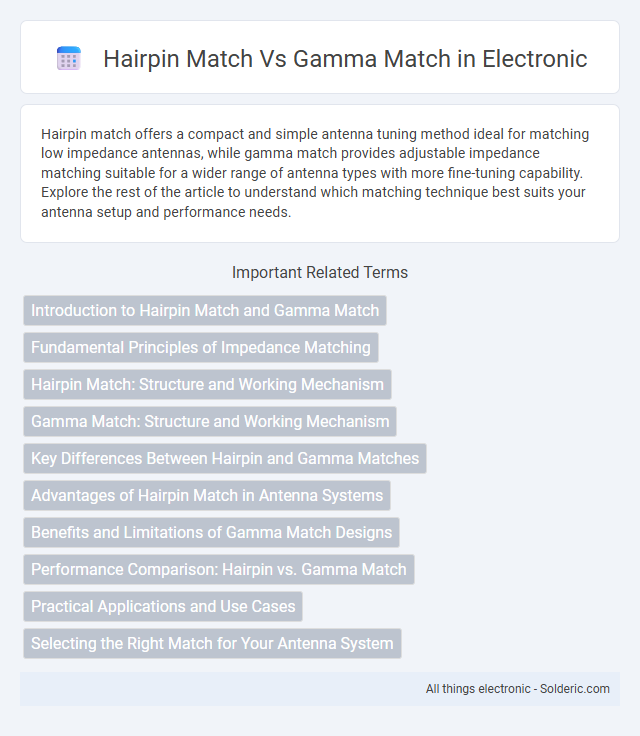Hairpin match offers a compact and simple antenna tuning method ideal for matching low impedance antennas, while gamma match provides adjustable impedance matching suitable for a wider range of antenna types with more fine-tuning capability. Explore the rest of the article to understand which matching technique best suits your antenna setup and performance needs.
Comparison Table
| Feature | Hairpin Match | Gamma Match |
|---|---|---|
| Purpose | Impedance matching for balanced antennas | Impedance matching for unbalanced antennas |
| Construction | Folded conductive element forming a hairpin shape | Adjustable gamma rod parallel to driven element |
| Tuning Method | Adjusting hairpin length and spacing | Adjusting gamma rod length and position |
| Impedance Range | Typically 25 to 50 ohms | Wide range, commonly 20 to 75 ohms |
| Physical Size | Compact, suitable for small antennas | Requires more space due to gamma arm |
| Complexity | Simple and robust design | More complex mechanical adjustment |
| Application | Common in vertical and Yagi antennas | Used in verticals and some horizontal antennas |
| Balance Type | Balanced to balanced or balanced to unbalanced | Unbalanced to balanced with built-in matching |
Introduction to Hairpin Match and Gamma Match
Hairpin match and gamma match are two popular impedance matching techniques used in antenna systems to optimize signal transmission. Hairpin match uses a U-shaped conductor to create a precise reactance that cancels out the antenna's reactive component, improving bandwidth and efficiency. Gamma match employs an adjustable tapped section of the antenna feed point to achieve impedance matching without requiring a direct physical connection to the antenna element, allowing for easier tuning and compatibility with unbalanced feed lines.
Fundamental Principles of Impedance Matching
Hairpin match and gamma match techniques both aim to achieve impedance matching by adjusting the reactive components in antenna feed systems. The hairpin match uses a shorted transmission line stub to cancel out reactive impedance, effectively tuning the antenna to the desired resonant frequency. In contrast, the gamma match employs a series capacitor and adjustable tap point on the antenna element to transform impedance, allowing fine control over both resistance and reactance for optimized antenna performance.
Hairpin Match: Structure and Working Mechanism
The hairpin match uses a folded wire or strip bent into a U-shape to act as an adjustable inductive element that fine-tunes the antenna's impedance, improving signal performance. Its simple structure allows for compact size while providing precise control over reactance to achieve resonance with the transmission line. By adjusting the length and placement of the hairpin, you can optimize antenna matching without complex components, enhancing overall RF efficiency.
Gamma Match: Structure and Working Mechanism
The gamma match features a coaxial structure with an adjustable tap on the driven element, enabling impedance matching by varying the distance along the antenna rod. Its working mechanism relies on creating a parallel transmission line that balances the unbalanced antenna feed, improving antenna efficiency without cutting or altering the driven element. You can easily fine-tune the gamma match for optimal SWR and resonance in Yagi and other directional antennas.
Key Differences Between Hairpin and Gamma Matches
Hairpin and gamma matches are both impedance-matching techniques used in antenna design, with key differences in their construction and tuning capabilities. A hairpin match consists of a U-shaped shorted transmission line stub that provides a simple and effective way to match the antenna's reactance, primarily used in folded dipoles and Yagi antennas. Gamma match, on the other hand, involves a series capacitor and adjustable tap on the driven element, offering greater flexibility for impedance adjustment and better control over reactance, commonly applied in dipole and vertical antennas.
Advantages of Hairpin Match in Antenna Systems
Hairpin match offers superior impedance matching with minimal signal loss, enhancing the overall efficiency of antenna systems. Its compact design reduces physical space requirements while providing stable bandwidth performance. You benefit from easier tuning and consistent impedance control compared to the more complex gamma match setup.
Benefits and Limitations of Gamma Match Designs
Gamma match designs offer precise impedance matching for Yagi antennas, enabling efficient power transfer and improved antenna performance. Their benefits include easy adjustability without disturbing the antenna's structure, making them suitable for high-frequency applications. However, gamma matches can introduce additional loss and require careful tuning to maintain antenna balance and minimize distortion.
Performance Comparison: Hairpin vs. Gamma Match
Hairpin matches provide superior bandwidth and lower signal loss compared to gamma matches, making them ideal for high-performance antenna tuning. Gamma matches offer easier adjustability and simpler construction but may introduce slightly higher resistance and reduced efficiency. Your choice depends on whether optimal efficiency or ease of tuning is a priority in your antenna system.
Practical Applications and Use Cases
Hairpin match antennas excel in ultra-wideband applications and are ideal for compact, portable devices requiring broad frequency coverage such as UWB radar systems and short-range wireless communications. Gamma match antennas offer precise impedance tuning, making them suitable for higher-power amateur radio transmitters and HF/VHF communication setups where minimizing signal loss and maximizing efficiency are critical. Practical use of hairpin matches favors ease of integration in low-profile designs, whereas gamma matches are preferred in robust, high-performance antenna installations with adjustable impedance needs.
Selecting the Right Match for Your Antenna System
Choosing between a hairpin match and a gamma match depends on your antenna's impedance and bandwidth requirements. Hairpin matches provide a simple, low-loss solution ideal for narrowband applications, while gamma matches offer adjustable impedance and wider bandwidth, making them suitable for tunable HF antennas. Evaluating your antenna's operating frequency, desired VSWR, and physical space will help determine the best matching network for optimal performance and signal clarity.
hairpin match vs gamma match Infographic

 solderic.com
solderic.com